Mirfield Parish Church
Historic Mirfield
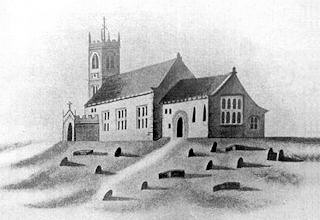
The Early Church
The Early Church
Before 1261 the inhabitants of Mirfield had to travel to Dewsbury to worship as they had no church of their own. The story goes that the wife of Sir John De Heton was waylaid and robbed on her way to worship in Dewsbury and as a result Sir John petitioned the Pope and was granted a dispensation to build a church in Mirfield. This church was replaced by a larger church in the 19th Century.
Before 1261 the inhabitants of Mirfield had to travel to Dewsbury to worship as they had no church of their own. The story goes that the wife of Sir John De Heton was waylaid and robbed on her way to worship in Dewsbury and as a result Sir John petitioned the Pope and was granted a dispensation to build a church in Mirfield. This church was replaced by a larger church in the 19th Century.
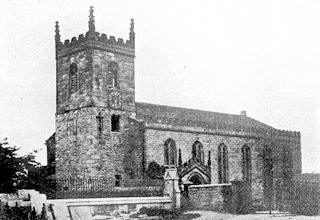
The Church of 1826
The 1826 Church
The early church served Mirfield up until 1826. The next church served the community only from 1826 until 1871 when the present church was built. The nave and chancel of the 1826 church were later demolished and the area enclosed by iron railings. The tower had also been the tower of the earlier church so on the suggestion of Sir Gilbert Scott, who was the architect for the present church, it was decided to preserve it. The pinnacled roof was substituted by the pointed roof as it is seen today. Stone from the demolished nave and chancel were used in the building of Eastthorpe School which has become Eastthorpe Visual Arts Centre following the closure of the school.
The early church served Mirfield up until 1826. The next church served the community only from 1826 until 1871 when the present church was built. The nave and chancel of the 1826 church were later demolished and the area enclosed by iron railings. The tower had also been the tower of the earlier church so on the suggestion of Sir Gilbert Scott, who was the architect for the present church, it was decided to preserve it. The pinnacled roof was substituted by the pointed roof as it is seen today. Stone from the demolished nave and chancel were used in the building of Eastthorpe School which has become Eastthorpe Visual Arts Centre following the closure of the school.
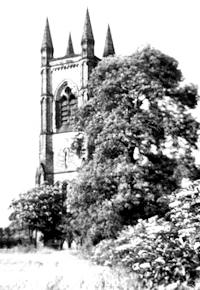
The Parish Church, 1960
Parish Church 1960
The first recorded Rector of Mirfield was Richard Le Vavasour who was appointed in 1247. The
27th was Joseph Ismay who was inducted on January 28th 1739 and for over 39 years he took a
keen interest in the everyday life and history of Mirfield. He recorded his observations in
his diaries which have since proved a rich source of information to historians. After his death
in 1778 he was said to be buried under the Alter Table in the Old Church. The Reverend George
Roland Hall, who was Vicar during my childhood, was the 39th Rector and was instituted on April
20th 1933. The photograph on the left shows the present church before houses were built on the
field in front of it.
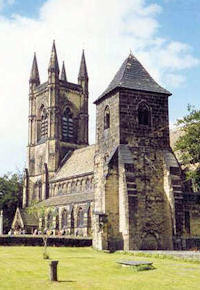
Present Church & Old Tower
St. Mary's & The Old Tower
The present church, built in 1871, is built on the site of the former Castle Hall. The architect was Sir George Gilbert Scott; the contractors were Messrs. W & J. Milner of Mirfield and it was built at a cost of £22,000. The tower stands 139 feet from base to pinnacle. The belfry has 10 bells that were installed in 1871 and overhauled in 1934 and again in 1984. The 3 dials of the clock are 8 feet in diameter.
The present church, built in 1871, is built on the site of the former Castle Hall. The architect was Sir George Gilbert Scott; the contractors were Messrs. W & J. Milner of Mirfield and it was built at a cost of £22,000. The tower stands 139 feet from base to pinnacle. The belfry has 10 bells that were installed in 1871 and overhauled in 1934 and again in 1984. The 3 dials of the clock are 8 feet in diameter.
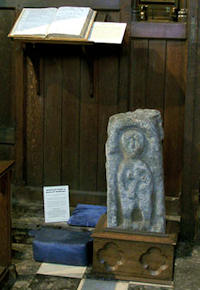
The Mirfield Stone
The Mirfield Stone
The Mirfield Stone is believed to be a grave monument dating from the late 11th century. It is 30.5 inches high, 11 inches broad, and tapers from 8 inches at the base to 9.5 inches at the top. It is made of reddish-brown sandstone and is rudely carved on all 4 sides. It is the only known example of a complete monument from that period. It stands in the Lady Chapel beneath the 16th century Book of Homilies which contains 12 homilies or sermons. Also in the Lady Chapel is a slab in commemoration of those who died in the Mirfield plague of 1631.
The face shown here depicts a figure with a cross. The other faces show a plaite of late Anglican pattern; a basket plaite; and the final side shows a beast.
The Mirfield Stone is believed to be a grave monument dating from the late 11th century. It is 30.5 inches high, 11 inches broad, and tapers from 8 inches at the base to 9.5 inches at the top. It is made of reddish-brown sandstone and is rudely carved on all 4 sides. It is the only known example of a complete monument from that period. It stands in the Lady Chapel beneath the 16th century Book of Homilies which contains 12 homilies or sermons. Also in the Lady Chapel is a slab in commemoration of those who died in the Mirfield plague of 1631.
The face shown here depicts a figure with a cross. The other faces show a plaite of late Anglican pattern; a basket plaite; and the final side shows a beast.
The Parish Church (St. Mary's) Choir in the 1950s
The pictures above are reproduced by courtesy of Michael J. Fretwell and show Mirfield Parish Church choir from the 1950s. Michael himself was a member of the choir around that time but only appears in one of the photos. The picture on the right is a mock wedding staged by choir members. Click on any picture for a larger image with more information and names, many of which were supplied from the prodigious memory of David Walker, himself a choir member at the time.
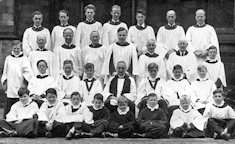
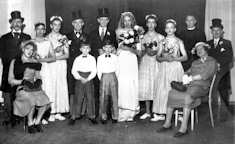
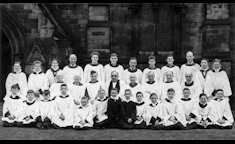 click for larger photo
click for larger photo